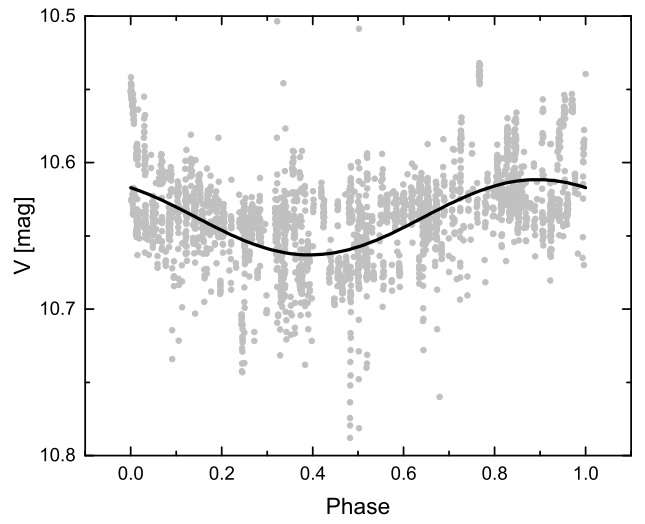February 20, 2017 report
New insights on the nature of the star V501 Aurigae revealed

(Phys.org)—Astronomers have presented the results of new photometric and spectroscopic observations of the star V501 Aurigae (V501 Aur for short), providing new insights into the nature of this object. The findings show that V501 Aur, previously considered to be T-Tauri star, is most probably a field binary. The study was published Feb. 15 in a paper available on arXiv.org.
V501 Aur was detected as an X-ray source in 1996 by the ROSAT space observatory. After the discovery, the source was classified as a possible new weak-lined T-Tauri star (WTTS) belonging to the Taurus-Auriga star-forming region. However, subsequent studies of this star provided evidence of its unseen stellar companion, suggesting that V501 Aur could be a single-lined spectroscopic binary.
In the latest study, a team of astronomers led by Martin Vaňko of the Astronomical Institute of Slovak Academy of Sciences in Tatranská Lomnica, Slovakia, has found that V501 Aur is a single-lined spectroscopic binary star.
"The spectroscopic observations reveal that V501 Aur is a single-lined spectroscopic binary system with a 68.8-day orbital period, a slightly eccentric orbit (e ∼ 0.03), and a systemic velocity discrepant from the mean of Taurus-Auriga," the paper reads.
The findings are based on a series of observational campaigns carried out between 1996 and 2016, utilizing telescopes and spectrographs worldwide. These observations allowed the team to reveal more details about the nature of this star.
"Information gathered since, as well as observations reported here, paint a rather different picture of the nature of the system that we now describe," the authors wrote.
According to the paper, V501 Aur is a rapidly rotating early K star with a radius of more than 26.3 solar radii. The spectroscopic observations also indicate that V501 Aur has a fairly massive unseen companion, making it a binary star. Moreover, the new evidence shows that V501 Aur is not a T-Tauri star, but is instead a field binary far behind the Taurus-Auriga star-forming region.
"The scenario that emerges for V501 Aur, aided by a comparison with stellar evolution models that succeed in matching all observational constraints, is one in which it is a background, non-eclipsing spectroscopic binary projected onto the Taurus-Auriga star-forming region, with a luminous, spotted, and fairly rapidly rotating giant star as the primary, and a likely much more rapidly rotating early-type star as the secondary," the researchers wrote in the paper.
Furthermore, the scientists estimated the mass of this binary system. Their calculations show that the primary star is about four times more massive than the sun, while its companion has a mass between 1.63 to 2.3 solar masses.
The findings also indicate that the system is roughly 180 million years old and is located approximately 2,600 light years away.
The team concluded that in order to uncover more details about V501 Aur, a detailed chemical analysis of this system should be performed. It could help us reveal its other parameters and improve our knowledge about its evolutionary state.
More information: On the nature of the candidate T-Tauri star V501 Aurigae, arXiv:1702.04512 [astro-ph.SR] arxiv.org/abs/1702.04512
Abstract
We report new multi-colour photometry and high-resolution spectroscopic observations of the long-period variable V501 Aur, previously considered to be a weak-lined T-Tauri star belonging to the Taurus-Auriga star-forming region. The spectroscopic observations reveal that V501 Aur is a single-lined spectroscopic binary system with a 68.8-day orbital period, a slightly eccentric orbit (e ~ 0.03), and a systemic velocity discrepant from the mean of Taurus-Auriga. The photometry shows quasi-periodic variations on a different, ~55-day timescale that we attribute to rotational modulation by spots. No eclipses are seen. The visible object is a rapidly rotating (vsini ~ 25 km/s) early K star, which along with the rotation period implies it must be large (R > 26.3 Rsun), as suggested also by spectroscopic estimates indicating a low surface gravity. The parallax from the Gaia mission and other independent estimates imply a distance much greater than the Taurus-Auriga region, consistent with the giant interpretation. Taken together, this evidence together with a re-evaluation of the LiI~λ6707 and Hα lines shows that V501 Aur is not a T-Tauri star, but is instead a field binary with a giant primary far behind the Taurus-Auriga star-forming region. The large mass function from the spectroscopic orbit and a comparison with stellar evolution models suggest the secondary may be an early-type main-sequence star.
© 2017 Phys.org



















